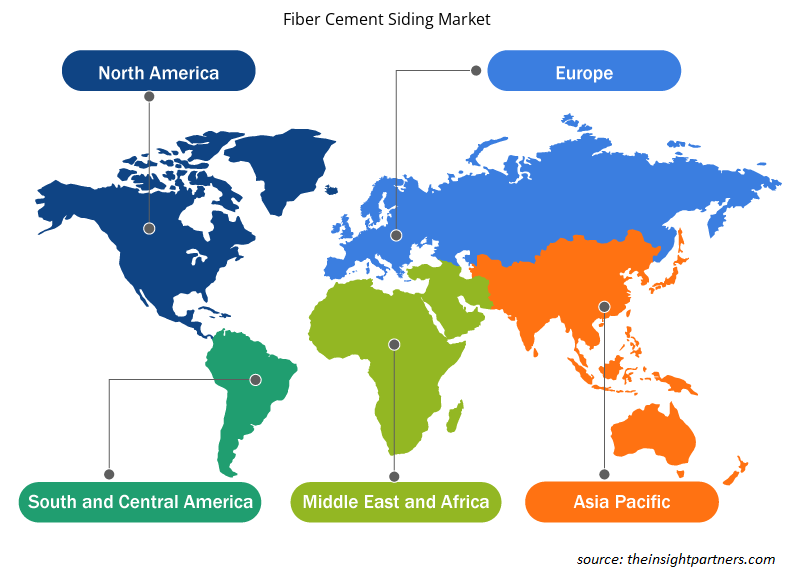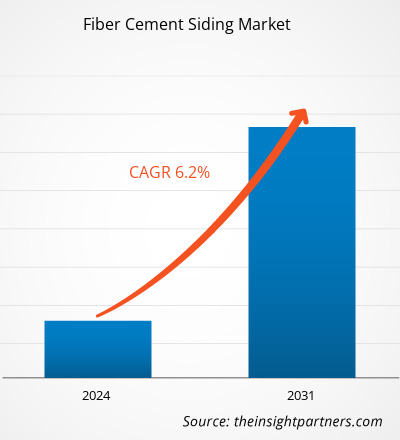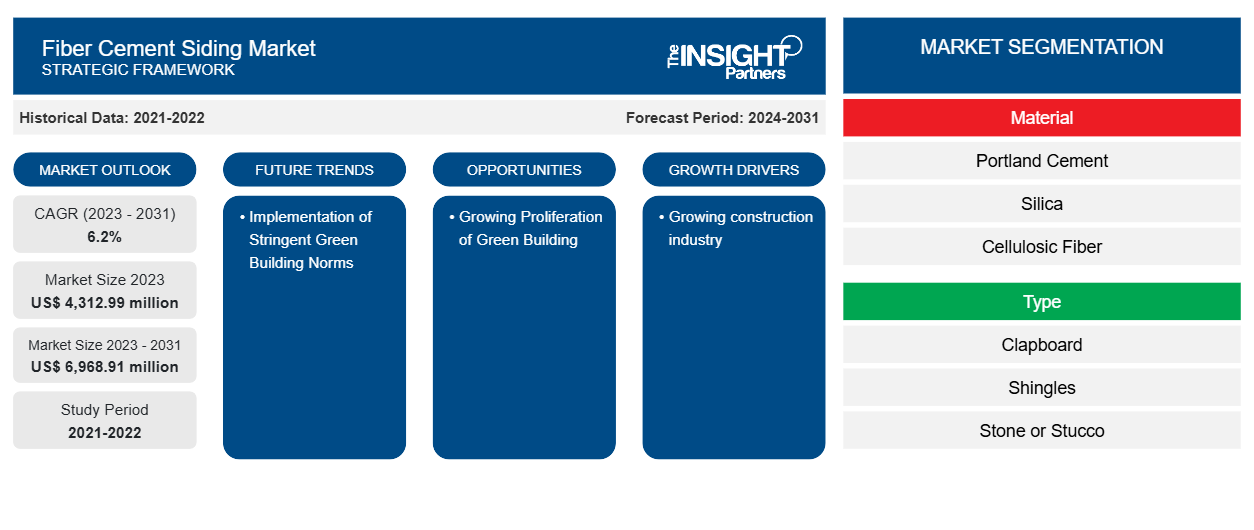Der Markt für Faserzementverkleidungen soll von 4.312,99 Millionen US-Dollar im Jahr 2023 auf 6.968,91 Millionen US-Dollar im Jahr 2031 anwachsen. Der Markt soll zwischen 2023 und 2031 eine durchschnittliche jährliche Wachstumsrate (CAGR) von 6,2 % verzeichnen. Die wachsende Zahl von Wohn- und Gewerbeinfrastrukturentwicklungen und der zunehmende Fokus auf die Nutzung kosteneffizienter Zementverkleidungen dürften ein wichtiger Trend auf dem Markt bleiben.
Marktanalyse für Faserzementverkleidungen
Die zunehmende Entwicklung im Bausektor wird voraussichtlich die Entwicklung von Faserzementverkleidungen weltweit vorantreiben. Die Bauindustrie in Industrieländern wie den USA, Kanada, Großbritannien und anderen ist in den letzten Jahren stark gewachsen. Die Regierungen dieser Länder fördern öffentlich-private Partnerschaften zur Umsetzung von Wohn-, Gewerbe- und Infrastrukturarbeiten. Dies hat in jüngster Zeit weltweit zu mehr Wohn- und Gewerbegebäuden geführt , was das Wachstum des Marktes für Faserzementverkleidungen fördert.
Marktübersicht für Faserzementverkleidungen
Der Anstieg des Baus von Wohn- und Geschäftsgebäuden dürfte dem Markt weltweit lukrative Wachstumschancen bieten und sich somit positiv auf die Nachfrage nach Fassadenverkleidungen aus Faserzement auswirken. Darüber hinaus wirken auch die Smart-City-Projekte als Treiber des Marktes für Fassadenverkleidungen aus Faserzement. Höhere verfügbare Einkommen der Menschen aufgrund des wirtschaftlichen Wohlstands sind ein wichtiger Faktor, der den Markt für Fassadenverkleidungen aus Faserzement im Wohngebäudesektor antreibt. Somit führt die wachsende Zahl der Bautätigkeiten weltweit zu einer positiven Nachfrage nach Fassadenverkleidungen aus Faserzement.
Passen Sie diesen Bericht Ihren Anforderungen an
Sie erhalten kostenlos individuelle Anpassungen an jedem Bericht, einschließlich Teilen dieses Berichts oder einer Analyse auf Länderebene, eines Excel-Datenpakets sowie tolle Angebote und Rabatte für Start-ups und Universitäten.
-
Holen Sie sich die wichtigsten Markttrends aus diesem Bericht.Dieses KOSTENLOSE Beispiel umfasst eine Datenanalyse von Markttrends bis hin zu Schätzungen und Prognosen.
Markttreiber und Chancen für Faserzementverkleidungen
Wachsende Entwicklung in der Bauindustrie begünstigt den Markt
Die wachsende Bevölkerung hat weltweit zu einer hohen Nachfrage nach Wohn- und Gewerbebauaktivitäten geführt. Regionen wie Europa, Nordamerika, Asien-Pazifik und der Nahe Osten umfassen mehrere Entwicklungsländer, die eine starke Nachfrage nach Infrastrukturprojekten erzeugen. Die wachsende Bevölkerung dieser Länder ist der Haupttreiber für die Wohnungswirtschaft der Region, was dem Markt für Faserzementverkleidungen weltweit Auftrieb verleihen wird. Mit dem boomenden Bau von Gewerbe- und Wohngebäuden wächst der Markt für Faserzementverkleidungen in mehreren Ländern wie China und Japan aufgrund mehrerer Vorteile wie langfristige Energie- und Kosteneinsparungen, geringere Emissionen und allgemeine Umweltauswirkungen, besserer thermischer Komfort und kontinuierliche Belüftung und Frischluft im gesamten Gebäude, was zu verbessertem Komfort und Gesundheit führt. Das wachsende Konzept energieeffizienter Gebäude fördert auch das Wachstum des Marktes für Faserzementverkleidungen.
Wachsende Verbreitung von umweltfreundlichem Bauen
Mehrere staatliche Initiativen zur Einführung energieeffizienter und umweltfreundlicher Gebäude steigern die Nachfrage auf dem Markt für Faserzementverkleidungen. So sind beispielsweise Deutschland und Großbritannien aufgrund entsprechender staatlicher Investitionen die wichtigsten Länder, die sich auf den Bau energieeffizienter Gebäude konzentrieren. Dieser Faktor fördert das Wachstum des Marktes für Faserzementverkleidungen. Der technologische Fortschritt für die Entwicklung des Wohn- und Gewerbewohnungssektors im Einklang mit den Zielen der ökologischen Nachhaltigkeit wird voraussichtlich lokale und globale Akteure anziehen, die qualitativ hochwertige Faserzementverkleidungen anbieten, was im Prognosezeitraum voraussichtlich zu wachsenden Marktchancen führen wird.
Segmentierungsanalyse des Marktberichts für Faserzementverkleidungen
Wichtige Segmente, die zur Ableitung der Marktanalyse für Faserzementverkleidungen beigetragen haben, sind Produkttyp, Anwendung und Endbenutzer.
- Basierend auf dem Material ist der Markt für Faserzementverkleidungen in Portlandzement, Kieselsäure, Zellulosefasern und andere unterteilt. Das Portlandzementsegment hatte im Jahr 2023 einen größeren Marktanteil.
- Nach Typ ist der Markt in Schindeln, Dachschindeln und Stein oder Stuck unterteilt. Das Schindelsegment hielt im Jahr 2023 einen erheblichen Marktanteil.
- Nach Endverbraucher ist der Markt in Wohn- und Gewerbeimmobilien segmentiert. Das Wohnsegment hielt im Jahr 2023 einen erheblichen Marktanteil.
Marktanteilsanalyse für Faserzementverkleidungen nach Geografie
Der geografische Umfang des Marktberichts für Faserzementverkleidungen ist hauptsächlich in fünf Regionen unterteilt: Nordamerika, Asien-Pazifik, Europa, Naher Osten und Afrika sowie Süd- und Mittelamerika.
Nordamerika ist Marktführer. Die Wirtschaft Nordamerikas gilt als eine der größten der Welt. In den nordamerikanischen Ländern gibt es einige der größten multinationalen Unternehmen auf ihrem Territorium. In den USA gibt es im weltweiten Vergleich mehr Akteure auf dem Markt für Faserzementverkleidungen. Die in der Region ansässigen Bauunternehmen profitieren von den dort vorhandenen entwickelten Einrichtungen. Eine robuste Wirtschaft ermöglicht es der Regierung, mehr für Bauarbeiten zur weiteren Urbanisierung auszugeben. Dies hilft auch beim Bau von Gebäuden in der Region, was das Wachstum des Marktes für Faserzementverkleidungen in der Region unterstützen wird.
Regionale Einblicke in den Markt für Faserzementverkleidungen
Die regionalen Trends und Faktoren, die den Markt für Faserzementverkleidungen im Prognosezeitraum beeinflussen, wurden von den Analysten von Insight Partners ausführlich erläutert. In diesem Abschnitt werden auch die Marktsegmente und die Geografie für Faserzementverkleidungen in Nordamerika, Europa, im asiatisch-pazifischen Raum, im Nahen Osten und Afrika sowie in Süd- und Mittelamerika erörtert.

- Erhalten Sie regionale Daten zum Markt für Faserzementverkleidungen
Umfang des Marktberichts zu Faserzementverkleidungen
| Berichtsattribut | Details |
|---|---|
| Marktgröße im Jahr 2023 | 4.312,99 Millionen US-Dollar |
| Marktgröße bis 2031 | 6.968,91 Millionen US-Dollar |
| Globale CAGR (2023 - 2031) | 6,2 % |
| Historische Daten | 2021-2022 |
| Prognosezeitraum | 2024–2031 |
| Abgedeckte Segmente |
Nach Material
|
| Abgedeckte Regionen und Länder |
Nordamerika
|
| Marktführer und wichtige Unternehmensprofile |
|
Marktteilnehmerdichte: Der Einfluss auf die Geschäftsdynamik
Der Markt für Faserzementverkleidungen wächst rasant, angetrieben durch die steigende Endverbrauchernachfrage aufgrund von Faktoren wie sich entwickelnden Verbraucherpräferenzen, technologischen Fortschritten und einem größeren Bewusstsein für die Vorteile des Produkts. Mit steigender Nachfrage erweitern Unternehmen ihr Angebot, entwickeln Innovationen, um die Bedürfnisse der Verbraucher zu erfüllen, und nutzen neue Trends, was das Marktwachstum weiter ankurbelt.
Die Marktteilnehmerdichte bezieht sich auf die Verteilung der Firmen oder Unternehmen, die in einem bestimmten Markt oder einer bestimmten Branche tätig sind. Sie gibt an, wie viele Wettbewerber (Marktteilnehmer) in einem bestimmten Marktraum im Verhältnis zu seiner Größe oder seinem gesamten Marktwert präsent sind.
Die wichtigsten auf dem Markt für Faserzementverkleidungen tätigen Unternehmen sind:
- Swisspearl Group AG
- CSR GmbH
- Elementia SAB DE CV
- ETEX-Gruppe
- GAF Material Corporation
- James Hardie Industries Plc
Haftungsausschluss : Die oben aufgeführten Unternehmen sind nicht in einer bestimmten Reihenfolge aufgeführt.

- Überblick über die wichtigsten Akteure auf dem Markt für Faserzementverkleidungen
Neuigkeiten und aktuelle Entwicklungen zum Markt für Faserzementverkleidungen
Der Markt für Faserzementverkleidungen wird durch die Erhebung qualitativer und quantitativer Daten nach Primär- und Sekundärforschung bewertet, die wichtige Unternehmensveröffentlichungen, Verbandsdaten und Datenbanken umfasst. Nachfolgend sind einige der Entwicklungen auf dem Markt für Faserzementverkleidungen aufgeführt:
- Die Swisspearl Group in Niederurnen, Schweiz, hat die dänische Cembrit übernommen. (Quelle: Swisspearl Group, Pressemitteilung, Juni 2022)
- James Hardie Industries Plc hat in Melbourne, Victoria, ein Grundstück erworben, um dort eine Fabrik für Faserzementplatten zu errichten. (Quelle: James Hardie Industries Plc, Pressemitteilung, März 2022)
Marktbericht zu Faserzementverkleidungen – Umfang und Ergebnisse
Der Bericht „Marktgröße und Prognose für Faserzementverkleidungen (2021–2031)“ bietet eine detaillierte Analyse des Marktes, die die folgenden Bereiche abdeckt:
- Marktgröße und Prognose für Faserzementverkleidungen auf globaler, regionaler und Länderebene für alle wichtigen Marktsegmente, die im Rahmen des Projekts abgedeckt sind
- Markttrends für Faserzementverkleidungen sowie Marktdynamik wie Treiber, Einschränkungen und wichtige Chancen
- Detaillierte PEST- und SWOT-Analyse
- Marktanalyse für Faserzementverkleidungen mit Blick auf wichtige Markttrends, globale und regionale Rahmenbedingungen, wichtige Akteure, Vorschriften und aktuelle Marktentwicklungen
- Branchenlandschaft und Wettbewerbsanalyse, die die Marktkonzentration, Heatmap-Analyse, prominente Akteure und aktuelle Entwicklungen auf dem Markt für Faserzementverkleidungen umfasst
- Detaillierte Firmenprofile
- Historische Analyse (2 Jahre), Basisjahr, Prognose (7 Jahre) mit CAGR
- PEST- und SWOT-Analyse
- Marktgröße Wert/Volumen – Global, Regional, Land
- Branchen- und Wettbewerbslandschaft
- Excel-Datensatz
Aktuelle Berichte
Verwandte Berichte
Erfahrungsberichte
Grund zum Kauf
- Fundierte Entscheidungsfindung
- Marktdynamik verstehen
- Wettbewerbsanalyse
- Kundeneinblicke
- Marktprognosen
- Risikominimierung
- Strategische Planung
- Investitionsbegründung
- Identifizierung neuer Märkte
- Verbesserung von Marketingstrategien
- Steigerung der Betriebseffizienz
- Anpassung an regulatorische Trends























 Kostenlose Probe anfordern für - Markt für Faserzementverkleidungen
Kostenlose Probe anfordern für - Markt für Faserzementverkleidungen